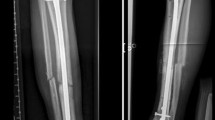Abstract
Purpose
The aim of this study was to evaluate the treatment of gap nonunion using non-vasularized fibula and corticocancellous bone grafting.
Methods
We analyzed 18 patients who had previously undergone a non-vascularized fibula strut and corticocancellous autograft procedure for gap nonunion of the lower limb. The mean gap was 5.9 cms, with 11 patients involving tibia gap nonunion and seven involving the femur. The mean age of the patients was 37.9 years, with a mean follow-up of 1.78 years. The patients underwent surgeries for femur nailing (static mode) and locking plates by standard technique using a standard lateral approach to the femur and tibia, respectively.
Results
The mean number of surgeries that each patient underwent was 3.17, with patients showing union at a mean of 15.8 weeks. Shortening was a common but acceptable complication, with the mean being 1.39 cms, along with three cases of failure.
Conclusion
The age-old method of non-vascularized fibula with autogenous corticocancellous bone grafting is a good method for treating nonunion, but patient selection as well as good bone grafting, rigid stability with an absence of infection, and good surrounding soft tissue vitality is mandatory for achieving success.



Similar content being viewed by others
References
Hertel R, Pisan M, Jacob RP (1995) Use of ipsilateral vascularised fibula for tibial reconstruction. J Bone Joint Surg Br 77(6): 914–919
Wilson PD Jr (1972) A clinical study of the biomechanical behavior of massive bone transplants used to reconstruct large bone defects. Clin Orthop Res Relat 87:81–109
Yadav SS (1990) Dual fibular grafting for massive bone gaps in the lower extremity. J Bone Joint Surg Am 72:486–494
Springfield D (1990) Autograft reconstructions. Orthop Clin North Am,1996 27:483–92
Lee EH, Goh JC, Helm R, Pho RW Donor site morbidity following resection of the fibula. J Bone Joint Surg Br; 72:129–31.
Enneking WF, Eady JL, Burchardt H (1980) Autogenous cortical bone grafts in the reconstruction of segmental skeletal defects. J Bone Joint Surg 62-A:1039–1058
Shahab M, Seah M, Fragomen AT, Rozbruck R (2012) Femoral lengthening with lengthening over a nail has fewer complications than intramedullary skeletal kinetic distraction. Clin Orthop Relat Res 470:1221–1231
Hakan D, Mehmet K, Levent E et al (2012) Functional results of lower extremity lengthening by motorized intramedullary nails. Acta Orthop Traumatol Turc 46(1):42–49
Keating,Simpson,Robinson et al. (2005) The management of fractures with bone loss;J Bone Joint Surg [Br];87-B:142–50.
Tuli SM (1972) Bridging of bone defects by massive bone grafts in tumorous conditions and in osteomyelitis. Clin Orthop Res Relat 87:60–73
Pho RWH, Levack B, Satku K, Patradul A et al (1985) Free vascularized fibular graft in the treatment of congenital pseudarthrosis of the tibia. J Bone Joint Surg 67-B:64–70
Pacelli LL, Gillard J, McLoughlin SW, Buehler MJ (2003) A biomechanical analysis of donor-site ankle instability following free fibular graft harvest. J Bone Joint Surg 85-A:597–603
Haw CS, O’Brien BM, Kurata T (1978) The microsurgical revascularization of resected segments of tibia in the dog. J Bone Joint Surg 60-B:266–269
Gore DR, Gardner GM, Sepic SB, Mollinger LA, Murray MP (1987) Function following partial fibulectomy. Clin Orthop res relat 220:206–10
Al-zahrani S, Harding MG, Kremli M, Khan FA, Ikram A, Takroni T (1993) Free fibular graft still has a place in the treatment of bone defects. Injury 24:551–554
Morsi E (2002) Tibial reconstruction using a non-vascularised fibular transfer. Int Orthop 26:377–380
Onuba O (1988) Chronic osteomyelitis—Use of ipsilateral fibulargraft for diaphyseal defects of the tibia. Trop Geogr Med 40:139–142
Mostafa E-S, Mahmoud E-H, Wael E-A (2007) Free non-vascularised fibular graft for treatment of post-traumatic bone defects. Acta Orthop Belg 73:70–76
El Gammal TA, El-Sayed A, Kotb MM (2002) Hypertrophy after free vascularized fibular transfer to the lower limb. Microsurgery 22:367–70
Falder S, Sinclair JS, Rogers CA, Townsend PL (2003) Longterm behaviour of the free vascularised fibula following reconstruction of large bony defects. Br J Plast Surg 56:571–584
Malizos KN, Nunley JA, Goldner RD, Urbaniak JR, Herreison JM (1993) Free vascularized fibula in traumatic long bone defect and in limb salvaging tumour resection: Comparative study. Microsurgery 14:368–74
Chmell MJ, McAndrew MP, Thomas R et al (1995) Structural allografts for reconstruction of lower extremity open fractures with 10 centimeters or more of acute segmental defects. J Orthop Trauma 9:222–226
Vidyadhara S, Vamsi K, Rao SK, Gnanadoss JJ, Pandian S (2009) Use of intramedullary fibular strut graft: a novel adjunct to plating in the treatment of osteoporotic humeral shaft nonunion. Int Orthop 33:1009–14
Fulkerson,Egol, Koval et al. (2006) Fixation of diaphyseal fractures with a segmental defect: a biomechanical comparison of locked and conventional plating techniques. J Trauma. Apr; 60 (4):830–5.
Zwierzchowski H, Zwierzchowska D, Synder M (1989) The value of fibular autografts in block resection of bone tumours and tumour like conditions. Int Orthop 13:113–117
Garba, Lawal,Dahiru et al. (2011) Use of non-vascularized autologous fibula strut graft in segmental bone loss;Annals of African Medicine Vol. 10, No. 1:25–8.
Acknowledgement
None.
Conflict of interest
None.
Author information
Authors and Affiliations
Corresponding author
Rights and permissions
About this article
Cite this article
Nataraj, B., Singh, V., Pathak, A.C. et al. Non-vascularized fibula and corticocancellous bone grafting for gap nonunion of lower limb—retrospective study of 18 cases—an age old technique revisited. Eur Orthop Traumatol 5, 277–283 (2014). https://doi.org/10.1007/s12570-014-0254-2
Received:
Accepted:
Published:
Issue Date:
DOI: https://doi.org/10.1007/s12570-014-0254-2




